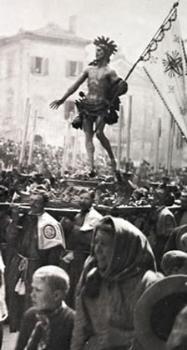


The agricultural year was also regulated according to the liturgical year
Farmers with hay sheaves for benediction, 17 th January, 1913, Fototeca Furio del Furia, Foiano della Chiana
The agricultural year was also regulated according to the liturgical year in order to favour the harvests to the maximum through the intercession of the deities. At other times, simple superstition brought about the same help. The principal moments of the year are as follows:
The last day of Carnival:
A ceremony with a definite pagan flavour – bringing light to the grain –took place on this day. People bearing lit straw torches went into the fields at night reciting a propitiatory chant. During feasts at the beginning of the year (carnival) the dances had steps that imitated jumps (the Trescone in Tuscany and the Saltarello in the Marches), in the belief that the higher the jumps, the taller the wheat would grow.
Palm Sunday:
To protect the new shoots of wheat, olive branches that had been blessed were placed in the fields (ancient fertility rites linked to the return of spring). To prevent reapers’ backache, a somersault was executed when the first returning swallow was spotted, or the reaper’s back was rubbed while walking in a circle around the parish church column.
Ascension Day (40 days after Easter):
For this feast the most important rogations took place (solemn supplications made on the three consecutive days before Ascension Day), which was a Tuscan Christianization of the ancient lustratio agrorum. The procession moved about the countryside stopping in front of every wayside cross, where they recited short prayers and psalms. Ascension Day, a day of fasting, marked the close of these rituals.
3rd May:
Crosses were made by weaving around two crossed sticks a lily and a twig of the olive blessed on Palm Sunday.
These little crosses were planted in vegetable gardens and fields in the hope of bringing good harvests.
Flower decorations:
In addition to floral decorations of a sacred nature, there was the practice of dropping a donkey, a fox, a dog and a cat from a church bell tower. Depending on how the animals fell, they forecast the type of harvest there would be..
St. John:
The patron saints of the harvest were St. John (24th June) and St. Peter (29th June). The feast of St. John coincides with the summer solstice. If the harvest had not begun by the feast of St. John because the grain was not yet ripe, a small bunch of wheatears was harvested as a propitiatory offering. The dew that fell on the wheat on the morning of St. John was used to make bread. Eating it served to gain an indulgence and was also a devotional act. Certain plants, such as camomile, were believed to have greater medicinal powers.
29 th June, SS Peter and Paul:
A bonfire of straw was lit.
26 th July, St. Ann:
It was forbidden to thresh. A small reed cross together with an olive branch that had been blessed was placed on top of a straw stack as a protection against lightning strikes.
10 th August, St. Lawrence:
In the area of Grossetto deals related to farming were agreed upon.
15 th August, The Assumption:
Bonfires of straw were lit in the evening.
25 th August, St. Genesio:
Protector of epileptics: a child's weight was offered in grain as a plea for the child to be cured.
24 th December:
On the evening of Christmas Eve an olive or juniper log was burnt. The number of sparks and the direction in which they flew were read as omens of various kinds. On the morning of the Epiphany, the charcoal from the log was scattered over the fields to favour good harvests.

The risen Christ in procession in 1919. Fototeca Furio del Furia, Foiano della Chiana.